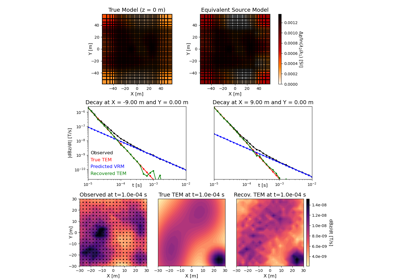simpeg.regularization.Smallness#
- class simpeg.regularization.Smallness(mesh, **kwargs)[source]#
Bases:
BaseRegularizationSmallness regularization for least-squares inversion.
Smallnessregularization is used to ensure that differences between the model values in the recovered model and the reference model are small; i.e. it preserves structures in the reference model. If a reference model is not supplied, the starting model will be set as the reference model in the corresponding objective function by default. Optionally, custom cell weights can be included to control the degree of smallness being enforced throughout different regions the model.See the Notes section below for a comprehensive description.
- Parameters:
- mesh
regularization.RegularizationMesh Mesh on which the regularization is discretized. Not the mesh used to define the simulation.
- active_cells
None, (n_cells, )numpy.ndarrayofbool Boolean array defining the set of
RegularizationMeshcells that are active in the inversion. IfNone, all cells are active.- mapping
None,simpeg.maps.BaseMap The mapping function applied to the model parameters. Use a mapping to get from model parameters to physical properties in active cells in the mesh. If
None, the mapping is the identity map.- reference_model
None, (n_param, )numpy.ndarray Reference model. If
None, the reference model in the inversion is set to the starting model.- units
None,str Units for the model parameters. Some regularization classes behave differently depending on the units; e.g. ‘radian’.
- weights
None,dict Weight multipliers to customize the least-squares function. Each key points to a (n_cells, ) numpy.ndarray that is defined on the
regularization.RegularizationMesh.
- mesh
Attributes
Weighting matrix.
Active cells defined on the regularization mesh.
Mapping from the inversion model parameters to the regularization mesh.
The model parameters.
Number of model parameters.
The parent objective function
Reference model.
Regularization mesh.
Units for the model parameters.
Return the keys for the existing cell weights
Methods
__call__(m)Evaluate the regularization function for the model provided.
deriv(m)Gradient of the regularization function evaluated for the model provided.
deriv2(m[, v])Hessian of the regularization function evaluated for the model provided.
f_m(m)Evaluate the regularization kernel function.
f_m_deriv(m)Derivative of the regularization kernel function.
get_weights(key)Cell weights for a given key.
map_classalias of
IdentityMapremove_weights(key)Removes the weights for the key provided.
set_weights(**weights)Adds (or updates) the specified weights to the regularization.
test([x, num, random_seed])Run a convergence test on both the first and second derivatives.
Notes
In case no mapping or reference model is used, we define the regularization function (objective function) for smallness as:
\[\phi (m) = \int_\Omega \, w(\mathbf{r}) \, \left\lvert m(\mathbf{r}) - m^\text{ref}(\mathbf{r}) \right\rvert^2 \, d\mathbf{r}\]where \(m(\mathbf{r})\) is the model, \(m^\text{ref}(\mathbf{r})\) is the reference model, and \(w(\mathbf{r})\) is a user-defined weighting function.
For the implementation within SimPEG, the regularization function and its variables must be discretized onto a mesh. The discretized approximation for the regularization function (objective function) is expressed in linear form as:
\[\phi (\mathbf{m}) = \sum_i \tilde{w}_i \, \left\lvert \, m_i - m_i^\text{ref} \, \right\rvert^2\]where \(m_i \in \mathbf{m}\) are the discrete model parameter values defined on the mesh, and \(\tilde{w}_i \in \mathbf{\tilde{w}}\) are amalgamated weighting constants that:
account for cell dimensions in the discretization, and
apply any user-defined weighting.
This is equivalent to an objective function of the form:
\[\phi (\mathbf{m}) = \left\lVert \mathbf{W} \left[ \mathbf{m} - \mathbf{m}^\text{ref} \right] \right\rVert^2\]where \(\mathbf{m}\) is the model vector, \(\mathbf{m}^\text{ref}\) is the reference model vector, and \(\mathbf{W}\) is the weighting matrix,
Mapping function
In case make use of a mapping function \(\mu\) that maps values of the model into a different space, then the regularization function for smallness gets defined as:
\[\phi (m) = \int_\Omega \, w(\mathbf{r}) \, \left\lvert \mu(m(\mathbf{r})) - \mu(m^\text{ref}(\mathbf{r})) \right\rvert^2 \, d\mathbf{r}\]In a discretized form, the previous equation is expressed as:
\[\phi (\mathbf{m}) = \sum_i \tilde{w}_i \, \left\lvert \, \mu(m_i) - \mu(m_i^\text{ref}) \, \right\rvert^2\]And in matrix form:
\[\phi (\mathbf{m}) = \left\lVert \mathbf{W} \left[ \mu(\mathbf{m}) - \mu(\mathbf{m}^\text{ref}) \right] \right\rVert^2.\]Custom weights and the weighting matrix
Let \(\mathbf{w_1, \; w_2, \; w_3, \; ...}\) each represent an optional set of custom cell weights. The weighting applied within the objective function is given by:
\[\mathbf{\tilde{w}} = \mathbf{v} \odot \prod_j \mathbf{w_j}\]where \(\mathbf{v}\) are the cell volumes. The weighting matrix used to apply the weights for smallness regularization is given by:
\[\mathbf{W} = \textrm{diag} \Big ( \, \mathbf{\tilde{w}}^{1/2} \Big )\]Each set of custom cell weights is stored within a
dictas an (n_cells, )numpy.ndarray. The weights can be set all at once during instantiation with the weights keyword argument as follows:>>> reg = Smallness(mesh, weights={'weights_1': array_1, 'weights_2': array_2})
or set after instantiation using the set_weights method:
>>> reg.set_weights(weights_1=array_1, weights_2=array_2)
The default weights that account for cell dimensions in the regularization are accessed via:
>>> reg.get_weights('volume')
Galleries and Tutorials using simpeg.regularization.Smallness#

Method of Equivalent Sources for Removing VRM Responses
